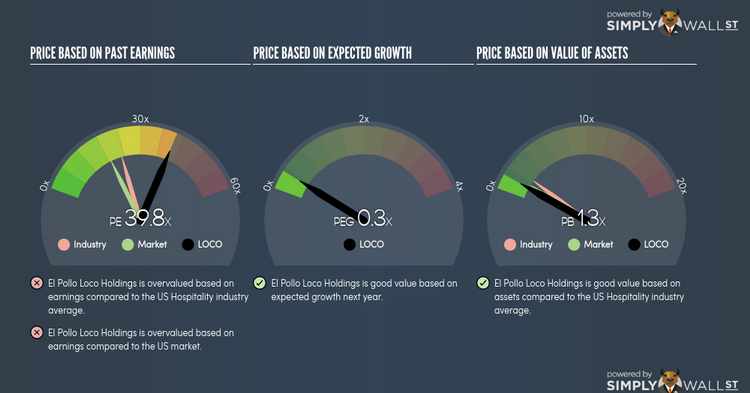Is It Time To Sell El Pollo Loco Holdings Inc (NASDAQ:LOCO) Based Off Its PE Ratio?

El Pollo Loco Holdings Inc (NASDAQ:LOCO) is currently trading at a trailing P/E of 39.8x, which is higher than the industry average of 23.1x. Although some investors may jump to the conclusion that you should avoid the stock or sell if you own it, understanding the assumptions behind the P/E ratio might change your mind. In this article, I will break down what the P/E ratio is, how to interpret it and what to watch out for. Check out our latest analysis for El Pollo Loco Holdings
Breaking down the Price-Earnings ratio
A common ratio used for relative valuation is the P/E ratio. By comparing a stock’s price per share to its earnings per share, we are able to see how much investors are paying for each dollar of the company’s earnings.
P/E Calculation for LOCO
Price-Earnings Ratio = Price per share ÷ Earnings per share
LOCO Price-Earnings Ratio = $9.4 ÷ $0.236 = 39.8x
The P/E ratio itself doesn’t tell you a lot; however, it becomes very insightful when you compare it with other similar companies. We want to compare the stock’s P/E ratio to the average of companies that have similar characteristics as LOCO, such as size and country of operation. A common peer group is companies that exist in the same industry, which is what I use. At 39.8x, LOCO’s P/E is higher than its industry peers (23.1x). This implies that investors are overvaluing each dollar of LOCO’s earnings. Therefore, according to this analysis, LOCO is an over-priced stock.
Assumptions to be aware of
Before you jump to the conclusion that LOCO should be banished from your portfolio, it is important to realise that our conclusion rests on two assertions. Firstly, our peer group contains companies that are similar to LOCO. If this isn’t the case, the difference in P/E could be due to other factors. For example, if you compared higher growth firms with LOCO, then its P/E would naturally be lower since investors would reward its peers’ higher growth with a higher price. The second assumption that must hold true is that the stocks we are comparing LOCO to are fairly valued by the market. If this does not hold true, LOCO’s lower P/E ratio may be because firms in our peer group are overvalued by the market.
To help readers see pass the short term volatility of the financial market, we aim to bring you a long-term focused research analysis purely driven by fundamental data. Note that our analysis does not factor in the latest price sensitive company announcements.
The author is an independent contributor and at the time of publication had no position in the stocks mentioned.

